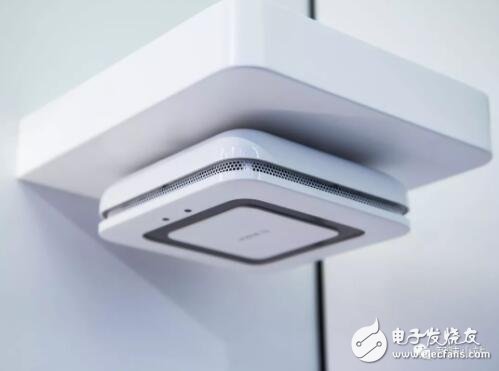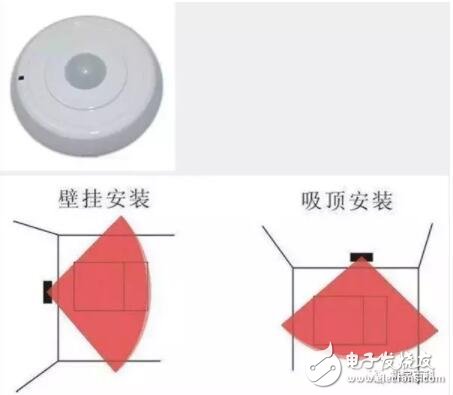As we all know, fires bring serious disasters to families, ranging from financial losses to personal injuries. For a family, there are many reasons for a fire: careless use of fire, smoking, children playing with fire, aging of electrical equipment, and electrical equipment. Installation is not in compliance, etc., and the smart home detector is not soft in preventing fires. It is like a loyal home guard. It can control the fire in time and stifle the danger in the cradle at the beginning of the fire. The smart home detector is explained in detail below. Correct installation and working principle.

(1) Wireless smoke detector
The wireless smoke detector is a kind of smoke detector that can accurately detect smoke. When the smoke concentration exceeds the limit, the sensor emits an audible and visual alarm, and outputs an alarm signal to the collector. The smoke detector uses an ionic smoke sensor. The smoke sensor is stable and reliable, and is widely used in various fire alarm systems and smart home systems.
Working principle and installation of smart home wireless smoke detector:After the wireless smoke detector is installed, people can monitor whether there are gas leaks, fire hazards, etc. in the home in real time. It is very convenient. The wireless smoke detector has the radioactive source americium 241 in the internal and external ionization chambers, and the positive and negative ions produced by ionization are in the electric field. Move to the positive and negative electrodes under the action of each. Under normal conditions, the current and voltage of the inner and outer ionization chambers are stable. Once there is smoke escaping outside the ionization chamber.
Interfering with the normal movement of charged particles, the current and voltage will change, and the balance between the inside and outside of the ionization chamber will be disrupted, so the wireless transmitter sends out a wireless alarm signal to notify the remote receiving host to transmit the alarm information, wireless smoke The detector adopts a smoke detection room based on the optical principle, which can accurately detect the smoke generated in the initial stage of the fire. It has a buzzer that can independently alarm the low-voltage alarm function. The installation height of the alarm is less than 6 meters, and the protection area is 60 square meters. .
1. Installation and use: select the surveillance area and install the alarm on the roof or ceiling of the surveillance area.
2. Precautions: Do not install outdoors; do not install in places with large air flow such as air inlets, ventilators, doors, etc.; do not install in places that exceed 10 ~ 50 ℃ or are relatively humid; the alarm installation location is away from the corner of the wall Must be greater than 0.75 meters; must be dust-proof and moisture-proof;
3. Maintenance: Due to dust and other factors, the sensitivity of the alarm will decrease, so it must be tested and maintained frequently; check the alarm once a week and press the test button; clean the alarm once every six months, turn off the power, and use A soft brush can clean the dust.
(2) Smoke detector:
The classification of smoke detectors is generally divided into point type and line type from the detection range, point type is divided into ion smoke and photoelectric smoke, and line type is divided into laser smoke and separated infrared beam smoke. Most of the smoke detectors suitable for our homes are photoelectric smoke detectors.
The working principle of photoelectric smoke detector:The photoelectric smoke detector is developed by using the basic property that the smoke produced during a fire can change the propagation characteristics of light. When the smoke concentration reaches a certain level, the photoelectric smoke detector sends out an alarm signal, according to the effect of smoke particles on the light. Absorption and scattering effects. Photoelectric smoke detectors are divided into shading type and astigmatism type. According to different access methods and battery power supply methods, they can be divided into networking type smoke detectors, independent type smoke detectors, and wireless type smoke detectors.
Networked smoke detectors are generally suitable for large-scale automatic fire alarm systems. Simple to understand, they need to be used with the central control host and cannot work independently, but the front-end signal collection has no on-site output function. Independent smoke detectors, Generally suitable for home use, it can collect the alarm signal on site, and send out the alarm sound and light on site, the installation is simple and easy to use.
Wireless smoke detectors are generally suitable for small home wireless alarm systems. They are used in conjunction with the central control host. They use wireless communication with the control host. The structure diagram of the photoelectric smoke detector is as follows. When the fire starts, when there is smoke, the smoke After entering the smoke storage cavity and the photosensitive element cannot receive the infrared light normally, the detector issues an alarm.

Precautions for installation of photoelectric smoke detector:
1. Smoke detectors should not be installed in places with high concentrations of smoke and water vapor.
2. The detector should be installed horizontally. When it is indeed necessary to install it, the inclination angle should not be greater than 45 degrees.
3. The horizontal distance between the detector and the wall and beam side should not be less than 5 meters; there should be no obstructions within 0.5 meters of the horizontal distance around the detector.
4. The horizontal distance from the detector to the nearest side of the air supply outlet of the air conditioner shall not be less than 5 meters; the horizontal distance to the orifice of the porous air supply top grid shall not be less than 0.5 meters.
(3) Wireless infrared detector
The infrared probe can only be installed indoors. The false alarm rate has a great relationship with the installation location. The correct installation location should be 2.0-2.2 meters away from the ground, away from air conditioners, refrigerators, stoves and other places sensitive to changes in air temperature.
1. The infrared probe should be installed in the corner of the room as far as possible to obtain the most ideal detection range. There should be no screens, furniture, large bonsai or other partitions in the detection range.
2. The infrared probe should be at a certain angle to the indoor walking line. The infrared probe is the least sensitive to radial movement, but is most sensitive to tangential (that is, the direction perpendicular to the radius) movement. Choose a suitable installation position on site. It is an extremely important part to avoid false alarms of infrared probes and obtain the best detection sensitivity.
(4) Installation requirements for door magnetic detectors
1. Install the door sensor detector on the door frame of the door or window you need to control, that is, fix the door sensor detector (main part, auxiliary part) on the frame of the door and window.
2. The false alarm rate has a great relationship with the installation position. The recommended installation position should be the gap between the main part and the auxiliary part ≤ 2mm.
(5) Installation requirements for household gas leak wireless alarms
Installation of home gas leak wireless alarm1. First determine the specific gravity of combustible gas and air, and then install the alarm at a suitable location within a radius of 1.5M from the gas source: A. Gas, which is lighter than air, floats in a high place; B. Natural gas, which is lighter than air, Floating in high places; C. Liquefied petroleum gas, which is heavier than air, is deposited in low places;
2. After the power is turned on, the alarm beeps once, and the power light is always on, the function light is flashing green, and it goes out after about 2 minutes, indicating that it has entered the alert state. When a gas leak is detected, it will emit a "di". , Di" alarm sound, and the function light flashes red at the same time, it will automatically enter the alert state after the alarm is removed;
3. If the sensor fails, the alarm will beep for a long time, and the function light will be yellow and bright. After the fault is removed, it will automatically enter the alert state.
Precautions:
Do not install outdoors;
Do not install in places with large air flow such as air inlets, ventilating fans, and doors;
Do not install in a place that exceeds 10 ~50°C or is relatively humid;
Do not install in a place where there are objects that separate the alarm from the gas equipment;
Avoid using a large number of solid hair sprays, insecticides, paint adhesives, diluted alcohol, etc. near the alarm;
If the alarm fails, do not disassemble and repair it yourself, but notify the supplier or the nearest agency to deal with it.
Shenzhen Jinziming Electronic Technology Co.,LTD , https://www.powerchargerusb.com
